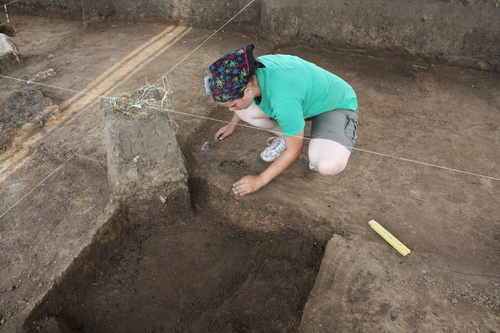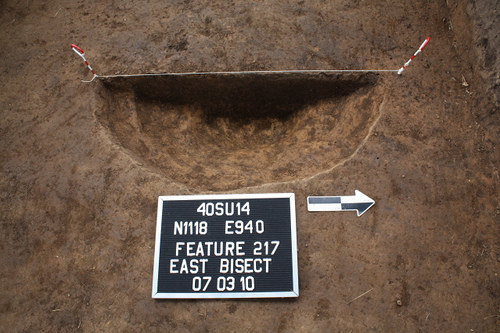
Field Projects: 2005-2011

| CASTALIAN SPRINGS ARCHAEOLOGICAL PROJECT Field Projects: 2005-2011
|
On June 7, we held an all-day orientation meeting on the MTSU campus. Fieldwork will commence on June 8.
After an orientation session on campus yesterday, we started our
first day in "The Field" today -- although sunny and warm, a nice day
with a good breeze most of the time. We have our largest crew ever on
this project this summer -- a total of 25 including students and
staff. This summer we are focusing our efforts on what we hope will prove to
be one of the most important public buildings at Castalian Springs. We
started investigations of this feature of the site briefly at the end of
last summer's work -- pursuing the results of our magnetometer and
ground-penetrating radar work. If the results of those surveys pan out,
we will be investigating a circular building 50-60 feet in diameter. Our brief investigations of this structure last summer -- three
excavation units crossing the western portion of the wall -- revealed a
striking pattern suggesting this was indeed a large major building on the
northeastern corner of the town plaza or center.
The different soil colors (outside and inside) as shown below, were
very promising when we closed up our investingations last summer. This morning, our first task was to transport our equipment and
supplies to the site to prepare for our five weeks of work here. Then we shifted to laying out seven new units for our crews -- these
units will start at the edge of our three units from last summer and
proceed eastward. This set of units should completely cross the large
building -- revealing the easternmost wall of the circle and the features
in the very middle of the structure. We anticipate a large central
fireplace or other type of feature to be there.
As others worked on the new units, most of the crew took the dirt out
of our three excavation units from last summer. These were lined with
plastic and filled with dirt last July to protect the unexcavated features
from the elements. After removing the plastic, the features from last year showed up in an
even more spectacular fashion than before. Last summer, during the
drought, the soil was very dry -- this summer, after our torrential rains
of the past few weeks, the soils were moist, which enhances the
differences in soil color.
After lunch, we had opened seven new excavation units and we had
finished stripping the sod from these -- ready to begin exposing what we
hope will prove to be a remarkable and important building over the next
five weeks. Tomorrow morning, we will start bright and early to work our way
through the plowzone to see what appears!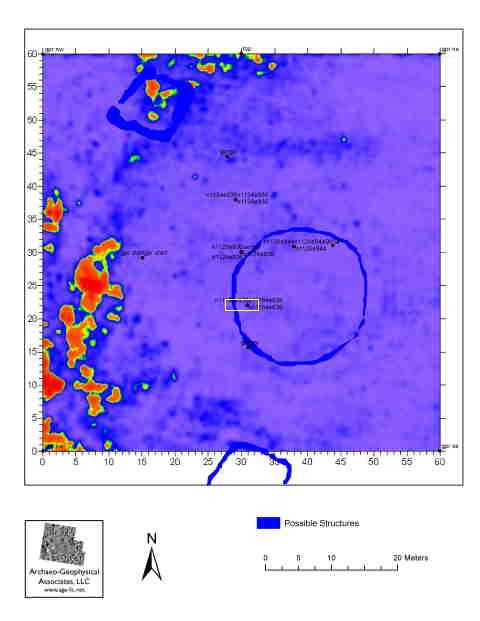



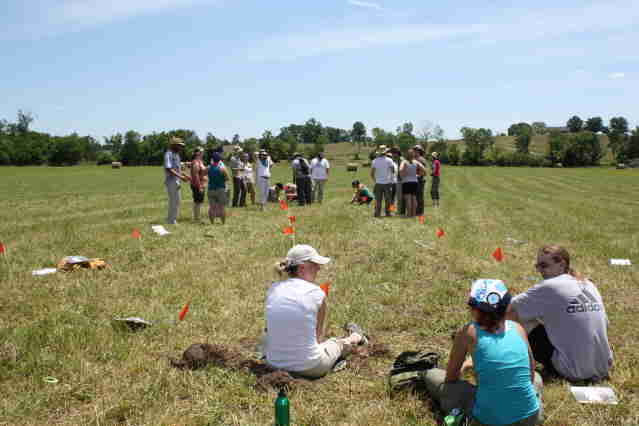

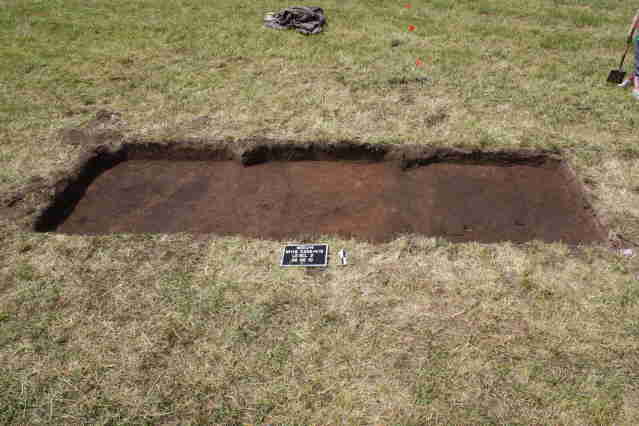

Today was -- in several different ways -- largely "a wash." I got up a
little earlier than usual this morning (around 5:00 am) -- excited about
what we might uncover during the day in our new excavation units. About
10 minutes later, the rain started. As Robert Burns said -- "the best
laid plans o' mice an' men gang aft agley."
So, Emily, Brandy and I (with help from Michael) went over early and
set up our "field lab" for the morning. By 8:00, the crew was
industriously washing artifacts from one of our past seasons -- with good
humor despite the cramped quarters and desire to be out in the field
working on our main goal of the summer.
The rain continued on and off through the morning. We broke for lunch
early at 11:00 -- hoping to catch an couple of hours digging in the early
afternoon before the next round of rain appeared.
We did indeed catch a break from the rain around 12:30 -- and managed
to get almost two hours of digging completed before the next round of
showers arrived.
With rain impending for the rest of the afternoon, we dismissed a
little early at 3:00 today -- with hopes that tomorrow will hold five or
six hours of fieldwork for us, and only an hour or two of rain!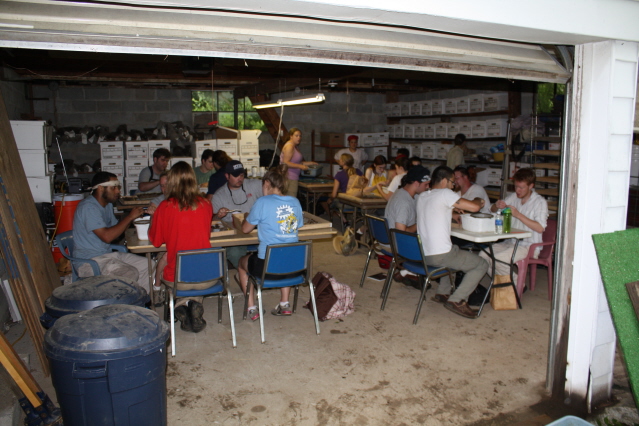
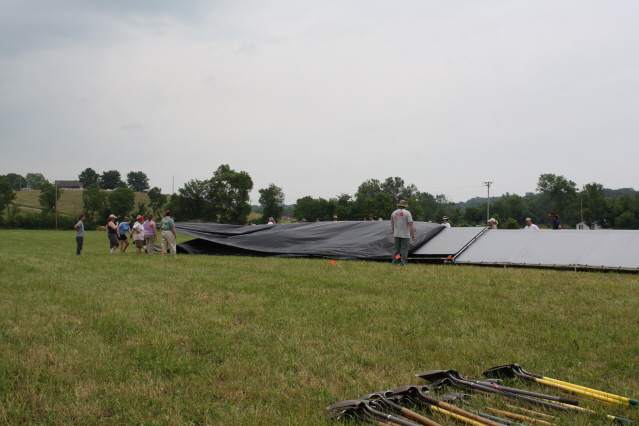
Our third day in the field turned out to be the best so far -- no rain
to interrupt our explorations. The heat and humidity were both a little
higher than we would have liked -- but overall we had a great day
together. Early this morning as we drove into the site, we noticed one of our
long time friends at the site perched on the dead tree -- one of the two
great blue herons that frequent the area. He or she waited long enough
for us to capture him in his elegant perch. As the day proceeded, our crew members worked diligently to remove the
first and second levels of the plowzone -- to get down to the top of the
intact and undisturbed parts of this ancient Native American town. As the hours proceeded, we learned a great deal about the best ways to use shovels and trowels as tools in archaeology. Below, Brandon and Skylar
practice their troweling skills. We also had a special guest volunteering on the project today (and through Saturday) -- Robert Sharp from the Art Institute of Chicago came to both
visit and assist with shoveling and troweling. Despite the 60% chance of rain for today -- we made it through the entire day working on our excavation units. If the weather holds, we should be
finished with the plow-disturbed soils overlying our feature sometime by mid-day tomorrow. So -- check back to see what tantalizing hints may be
revealed then.


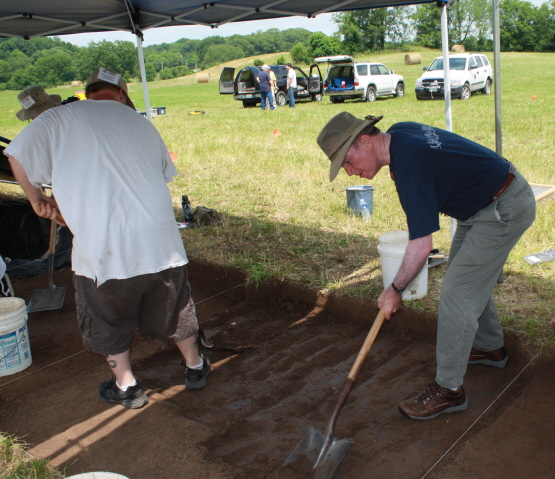
Despite the threat of rain, we made it through our fourth day in the field without getting wet (well, soaked with sweat perhaps, but not from raindrops). The heat and humidity continued to be painfully high – but with plenty of water and rest breaks, everyone is holding up well. We’re still working almost entirely in the plow-zone today – despite the shade from our shelters, the heat and wind dry the soil quickly and it is tough going. Across much of the site that we’ve explored, the plowzone ranges from 10-14 inches in depth. Each new area we examine is different. Perhaps more importantly, our first week is a learning period for the students and staff – getting to know each other and how to work together as a team. The members of each of our seven crews have to get to know each other, learn the strengths and weaknesses together, and figure out how to accomplish their mutual goals. And, we all have to learn to work together as a 25-member team. Below Ellen-Craig measures the depth of their excavations while Andrew and Rusty learn to take notes. In the background, Amy screens soil from the adjacent unit. By the end of the day, we were nearing the bottom of the plowzone – differences in soil colors like those shown below had begun to appear in many units.
After a long hot and humid day, we closed up. More as the days proceed!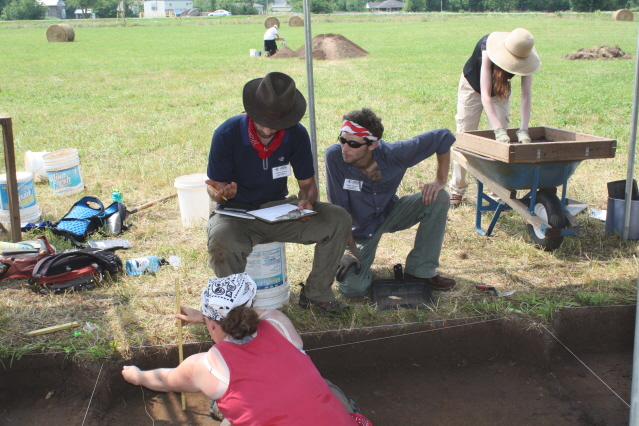

Today was the first of our Saturday Volunteer Days, where we invite interested members of the community to work alongside us to see how archaeology is done. Frequently, our first volunteer day of the season is a bit slim – until the word of mouth gets out. Plus, there were heat advisories out for the mid-state today – with the heat soaring into the upper 90s at Castalian Springs. We began with the daily trek across the field to our dig site. Our friend Robert from the Art Institute of Chicago was back again for the morning – below, I’m screening with Robert. A few other volunteers showed up, including Amy’s aunt Carol, shown below working together on the screen (Rusty is at left sharpening his shovel). Other volnnteers and visitors included Lee’s friend Brittain, and Libby’s mother Jane with friend David. As we continue to excavate, it is clear that 20 centimeters is not through our plowzone. Although differences in soil color, larger stones, and other objects are starting to show up – they remain unclear. Given the heat, we closed up at noon today. Hopefully on Monday we’ll begin to see some light! While most of the staff will be working tomorrow, our students are looking forward to a welcome break on Sunday from the heat, humidity, and hard labor.


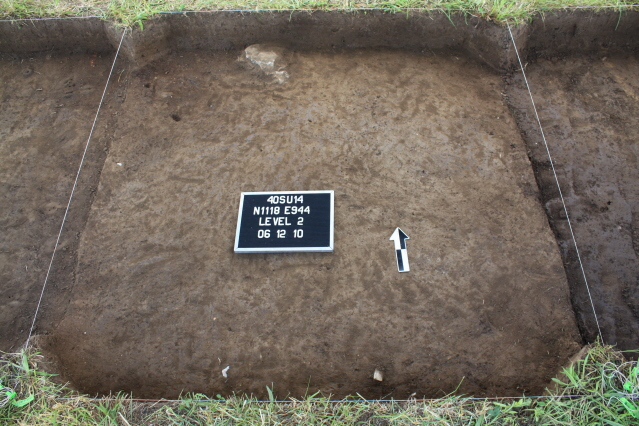
We returned rested -- but sore and a bit blistered -- on a fine Monday morning to continue our investigation of the Castalian Springs community. With ten excavation units opened across our circular anomaly and down to 20 cm or more in all of them, possible walls, hearths, posts, and pits began to emerge everywhere. This nearly 70 foot trench across the circle is exciting -- but difficult to understand and interpret today. Imagine that you took a six-foot width trench through the middle of your own house -- and all you could see was the tiny parts of walls and doors from that six-foot wide trench. We have a tiny emerging picture of something large and complex. As we struggled with trying to understand our discoveries, we moved several of our crews to the top of Mound 2 -- the large platform mound -- to strip the sod from some units. During the day, I cut a deeper sounding into one of the units to see if the features would become more clear. As the photo below perhaps shows, I discovered that we needed another 10 or 15 cm of excavation to be able to clearly define our structural features. If you examine the north wall and floor of the sounding below, you'll perhaps see that as I proceeded deeper, a dark black half-circle emerged -- half of a very clear posthole. We are not deep enough yet to figure out what we have. As we closed the day, we were left knowing that we have to return to these units and dig them a bit deeper to understand what we have. Also, as the heat soared into the upper 90s this afternoon, we unanimously agreed to change our work schedule to 7:00 am - 3:30 pm -- an hour earlier -- so we will be leaving as the hottest heat of the day emerges.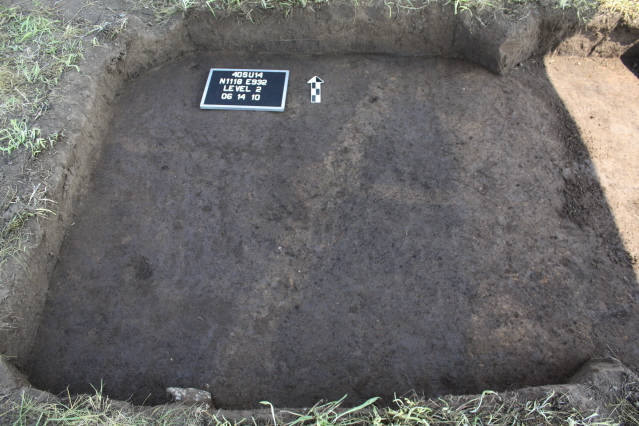



We started our new work schedule this morning -- bright and early at 7:00 am. It was quiet and comfortable when we began the day. As we proceed deeper below the plowzone, a few interesting artifacts have begun to emerge. Below, Libby, Amber, and Andrew examine a fragment and discuss what it might be. Interestingly, though, we are finding very few pieces of pottery, broken flint, and other objects in this area. Given it's prominent placement on the northeastern corner of the community plaza, we expected that this would be an important location -- something important for sacred or economic or political reasons. We didn't really expect there to be much "garbage' tossed out here -- and that is precisely what we are discovering. The soils are filled with features -- but not with very many artifacts or objects. Our backdirt pile continues to grow in height, width and length. Below, Brooke pushes a heavy load up to the top to dump. By the end of the day, almost all of our units were down to 30 cm below the surface (about a foot). As the photo below shows, the different colored soils are becoming more distinct -- but we are still not quite deep enough to see things clearly. If the rain holds off, we should be deep enough on Wednesday to show some clearer discoveries -- and perhaps we will start to understand our tiny window across this small mound and large building or enclosure.


A beautiful June morning -- cloudy and a constant cool breeze until the afternoon. Although this is an archaeological project with significant goals in terms of understanding the Mississippian era community at Castalian Springs, it is also called a "field school" -- a training period for prospective archaeologists and for those students who simply want to try their hand at archaeology. Below, Brandy -- our Field Director -- works with Brooke and Austin at the screen. All of the soil removed from our excavation units is passed through 1/4 inch hardware mesh screens -- recovering most of the identifiable artifacts therein. The heat and wind has dried things out substantially after our floods of May -- making the screening difficult. We are using shovels in our excavations to expedite removal of the upper 30-40 cm overlying the features. However, this is not the typical shoveling out big chunks at a time. The students are learning to "shovel skim" -- a technique shown below where the shovel is used more like a carpenter's plane or adze to remove a thin slice. The resulting flat surface allows us to see changes in soil color as they appear. All six of our crews continued removing the top zones from their units today. With twelve units open across the large circle, we are making good progress on our cross section. Today's work has confirmed that this small circular knoll is indeed an "Indian mound" -- an earthen structure created by Native Americans some 850 years ago or so. Beneath the plowzone, we encountered a 20-cm thick zone of fill dirt -- brought basketload by basketload here to seal in whatever lies beneath it. As we penetrate through this mound fill, a number of features have been exposed -- including a series of circular stains that once held posts for some kind of structure. The photo below shows two of these post holes inside the big circle -- the yellow arrows point to these disinctive stains. This photo shows a closeup of another posthole near the edge of the big circle -- this one still has some carbonized fragments of post preserved around the edge. Elsewhere, other intriguing hints of the architecture of this possible building are showing up -- near the center we have what may turn out to be a clay lined hearth or fireplace. We will work further on this feature on Thursday. In the eastern and western units, we have some stains that may be the outside walls of the circle -- again, further work in the next few days will clarify what we have there. More news tomorrow!




Another beautiful morning for work at the site -- relatively cool, breezy, and overcast. Our work continued steadily and in good spirits for the first 3 hours of the morning. Around 10 am, a quick moving stormfront moved across us -- we managed to get everything closed up and back to our field quarters before the rain arrived. The rain continued until a bit after noon, when we were able to head back to the field to open things back up. Below, Brandon, Austin, Michael, and Skyler guide the water off our plastic. The wet grass and brief showers left us with wet shoes and socks -- one of our crew members found a handy place to dry the socks in the early afternoon. Despite the brief interruption in the late morning, we continued our work to examine our possible public building. During the afternoon, I examined our possible hearth or fireplace in the middle of the circle. At this point, more excavation is needed to figure this out -- it could be the top of a disturbed hearth. It might also be the clay from around a smokehole at the top of the structure. But, during the process, I discovered an unusual little artifact. For lack of a better term, we just refer to these as clay marbles -- we don't know what they were used for, but they are beautifully prepared little marble-like objects made of clay. My wife carol dropped by this afternoon as well -- bringing some freezer pops for the students. A nice end to the day. More tomorrow.





Today started off with fog across the site with a 6:30 am temperature of 73. Unfortunately, the fog burned off all too soon, leaving behind an extraordinarily humid and increasingly hot afternoon. By mid-day, we had cleaned off enough of the excavations at two ends of our approximately 70 foot long trench to be convinced we have crossed both walls of the circle. The photo below (from a couple of days ago) shows the easternmost wall section -- the yellow lines show the inner (left) and outer edges of a wide trench, while the white circles show what appear to be the tops of postholes on the outside of the trench. The photo below, from this afternoon, shows the westernmost wall section -- again, the yellow lines show the inner (right) and outer edges of a wide trench, while the white circles show what appear to be the tops of possible postholes on the outside of the trench. On this side, at least the middle two of the postholes still contain the carbonized remnants of the posts themselves. In the trench between these posts, Field Director Brandy Dacus found tiny fragments of mica -- a prized mineral used for jewelry and regalia by the elites of Mississippian era towns. Convinced that we have a very similar looking feature 65 feet apart on the east and west, two of our crews laid out new units to the north and south -- dropping down on top of where the circle should be if it is indeed continuous. Although we barely got the sod stripped off of two units on the south, an interesting artifact showed up in the plowzone -- a flint drill bit. Since it is in the plowzone, we can't be sure that it is associated with activities inside the circular structure -- but it is made of a non-local stone and one that we know other Mississippian artifacts at the site were made from. We had a large number of visitors today -- Drs. Shannon Hodge and Tanya Peres from MTSU; Mike Moore and Aaron Deter-Wolf from the Division of Archaeology; Jesse Tune, an alum of our field school visiting from his grad program at American University; and Kelly Ledford from MTSU. I briefly continued work on the mass of daub in the center of the structure -- but didn't have time to make much sense of it. Maybe tomorrow. In the background below, Amy G. skims off the last few bits of soil from the base of their unit while Amber R. screens the soil. Tomorrow is the second of our volunteer days -- promising to be another hot and humid day.



Our second "Volunteer Saturday" started with a line of thundershowers around 6:00 am -- fortunately, the rain blew through by around 9;30 and we were able to begin work only a little later than planned. We had a record number of volunteers, students, and visitors today -- a total of 44! Students working with the volunteers included Andrew Brown, Alex Collins, Skylar Gleaves, Amy Goldstein, Amy Howell, ibby Knight, Kevin McDaniel, Ellen-Craig Russell, Amber Ryder, and Rusty Simmons. Volunteers included Ron Borders, Howie Brainerd, Ellis Durham, Bailey Gillreath, Gavin Hale, Alison and Sheryl Howell, LeAnne Johnson, Kerri Lorigan, Grady and Selah Lowery, Steaven C. and Steaven D. Robbins, Misty Ross, Joseph and Tiffany Saul, and Scooter and Ritchie Simmons. Our thanks to all for making the day a success -- despite the rain and heat. With so many workers, we were scattered across the site -- from the two units on the south wall, a new unit on the north wall (thanks to the Robbins and LeAnne for stripping the sod on that one!), and five units on the summit of Mound 2. Later in the day, Dr. Sarah Sherwood of Dickinson College brought the staff and students from her field school on the Cumberland Plateau for a visit. More news on Monday.
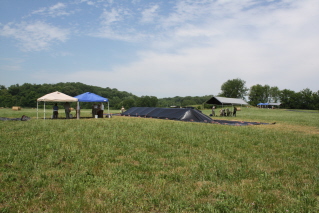

This morning was the coolest morning in over a week -- somewhat ironic considering the forecast of the hottest day of the year. As we continue to clean up and map the trenches, postholes, and other features, a number of interesting things have emerged. Below is a tiny piece of mica -- found adjacent to one of the posts in the western trench. The remains of several apparent charred posts were cleaned up in the western wall trench as well today. These will provide great samples for dating the construction of this structure -- we are the first to see these in perhaps 900 years. At the base of level 4 in one of our western units, two very clear postholes emerged underneath the mound fill (yellow arrows in photo below) along with another possible posthole (blue arrow).
In what should be near the exact center of the circle, the mound fill continues deeper than in surrounding units. This probably means that there was a depression in the center of the circle -- possibly a large hearth or fireplace. We will have to expose this feature further before removing the moundfill to expose what is beneath it. By noon, it was already 94 degrees in the shade beneath our tent shelters. With 100 degrees predicted for the afternoon, we took a break from the heat in the afternoon in the shade -- washing up artifacts. A miserably hot afternoon even in the shade -- we reached 100.1 at our lab, although the breeze and shade were a help. By 3:00 pm, it was 104 degrees in the shade down on the site. With similar heat predicted for tomorrow, we'll make the most of our morning in the field -- and head back to the lab to escape the worst of the heat. Hopefully by later in the week, we will be able to devote our full time to fieldwork.




Tuesday started off a few degrees warmer than usual -- and extremely humid. The forecast was for near record breaking temperatures in the afternoon. Our efforts to find the wall of the circular structure to the south were fruitful today -- the photo below shows the trench (highlighted in yellow) crossing the center of the units (from west to east). While we now have confidently identified the "top" of the trench on three sides (east, west, and south), we need to see the trench in three dimensions to make sure that is indeed a wall for a building. Brandy and Michael began a cross-section of the west wall today -- this narrow excavation unit will cross the feature from outside to inside and allow us to see how deep it goes and something of its construction. By noon, it was over 95 degrees in the shade beneath our tent shelters. Expecting once again to break 100 degrees in the afternoon, we retired for a couple of hours to our lab to wash artifacts. Although the predictions are for mid-90s tomorrow, we plan to work a full day if at all possible.

Today started off unexpectedly overcast and quite cool compared to earlier mornings in the week. The cloudy skies stayed with us most of the morning -- providing a welcome break. In order to fully expose the complex set of features in the center of the structure, we began opening three additional excavation units this morning. At left Ellen-Craig, Rusty, and Zach remove the sod from a new unit. As we proceed deeper beneath the plowzone and mound fill in some of our center units, a series of features are more clear. Below, a nearly three foot diameter probable posthole (yellow circle) emerged -- along with a linear trench. Just to the east of the large post, the clear outline of a large rectangular pit appeared. In order to see all of this pit, we will need to open one or two more units to the south. Brandy and Michael continued excavation of the wall cross-section throughout the day -- the photo below shows the north profile of the excavation. While not quite to the bottom, the contrast of dark colored fill in the wall trench with the light colored subsoil is very striking. At the end of the day, the cross-section was 1 meter deep. Unlike the rest of this structure, the upper fill in the wall trench does contain some Mississippian era artifacts, including a few potsherds, lithic debris, and the triangular chert arrowpoint shown below. We had a number of visitors to the site today, including a contingent from the Division of Archaeology and Ruth McWhirter from the University of Memphis. We made it through the hot humid afternoon -- but a considerable amount of work remains to be done. Today is the mid-point of our five week field season.




The morning started off overcast and (relatively) cool again -- with predictions for a slightly cooler afternoon, but with a good chance of rain and storms. Most of our team continued work on removing the sod and plowzone from new units, while others continued to work through Level 3 or 4 of previous units. We completed the cross-section of the wall trench by mid-morning -- revealing clear evidence that our circular anomaly is indeed a building of some kind. The trench for the wall of this building is different from anything I've seen before -- it has three "steps" descending from outside (west) to inside (east). Each step appears to have had posts in it at some point -- the largest and deepest on the interior. The fill in the lower part of these trenches is completely homogenous -- in others words, it doesn't appear that the three "steps" represent rebuilding of the structure. All three appear to have been filled with posts at the same time. Remnants of two of the shallower posts on the "outside" are still present (blue arrows). In our northern excavation units, the outline of the wall was clearly revealed today -- although we only captured about half of it. The blue line in the photo below highlights the northern edge of the trench -- the southern part of the trench will have to wait to be revealed when we open the unit to the south. After lunch (at 1:00 pm), things were still calm weatherwise at Castalian Springs, but rain and small thunderstorms were breaking out around us in all directions on very short notice. Since these small storms included strong gusting winds, heavy downpours, and lots of lightning, I decided we should stay in the lab again this afternoon. As things turned out, it never rained here -- but the weather was too unpredictable and unstable to make it safe for us out in the field.


Before 7 am this morning, it was overcast -- but warm and humid already. As we excavate more places across the site, it takes longer and longer to complete our morning routine of uncovering, setting up shelters, and getting ready to work. It also takes substantially longer to cover things up -- making the decisions about "Is it going to rain soon?" more critical. Although I misjudged the location of the wall trench on the north by a few feet and we will need to open another unit to the south (to the left in the photo below) -- this was in some ways a fortuitous mistake. The blue arrow points to the part of the wall trench for the circular building in the two units. Extending to the right (north), we uncovered a band of dark soil about 8 feet wide (the right edge of that band is highlighted in yellow below). We had suspected this circular structure might have an earthen embankment on the outside -- basically, a sloped bank of earth against the outside wall. This clearly defined dark band of earth is an exciting possibility for just such an embankment. We will need to cross-section this feature in the next few days to see what it looks like -- and how it fits together with the wall trench. Although the discoveries beneath the sod are a big part of our goals -- this class remains a training ground for budding archaeologists. Today, several of the crews took breaks from digging to learn how to take measurements with our transit. Here, Lee, Amber R. and Amy G. work on learning how to level the equipment. Elsewhere on site, Brandon, Kevin, and Skylar worked their way downwards in a new unit in the middle of the southwestern quadrant of the circular structure -- we're looking for large roof support posts at this point. While we are now satisfied that the wall trench is "real" and built by Native Americans some 800-900 years ago, we are not yet certain that it was a roofed building. Some large support posts would help to confirm the presence of a roof over the interior. In this area, the fill capping the structure seems to be deeper -- the mottled areas below are basketloads of fill over the structure interior. The yellow arrows point to darker circles that might be hints of postholes -- but they might also simply be basketloads of darker soil. We will have to proceed deeper into the unit to figure out which is more likely. Tomorrow is the third of our four volunteer days -- we will start off a bit later in the morning at 9:00 and hope to have a good day with our smaller student crew and volunteers.
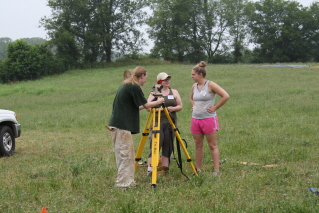

As the third of our four "Volunteer Saturdays" began, everyone was a bit subdued on the porch at our field house -- we are all a bit tired from the heat, dodging the rain (and lack of rain), and three weeks of long days. Fortunately, the excitement of our volunteers perked us up a bit! Below, I am giving some of our first time volunteers an orientation to our project and discoveries thus far -- Adelaide Corkern and children Claire and Clay; Bob and Tammy Wilson and son Austin. One of our field school alums Ron Borders also showed up to work for his second Saturday in a row. Later in the morning, Karen Peterson, Joey and Alex Keasler arrived to assist Kevin and Rusty with a new excavation unit -- one that we hope will reveal the entrance to the circular building in the next day or so. Dr. Shannon Hodge, our project bioarchaeologist from MTSU, visited later in the day with spouse Phillip (an alum of our field school program) and children John and Caroline. John (in the cowboy hat at left) is a experienced field school hand - having visited almost every year of our six years. Several members of Field Director Brandy Dacus' family visited later in the morning -- including her mother Jonna, grandfather John, sister clair, and cousin Kaylie. Although we made good progress excavating in several units, we only reached some solid new conclusions in our unit searching for roof supports -- 10 cm lower, four small but clear postholes emerged. Unfortunately, these are too small to be roof supports -- but they do appear to be some kind of interior partitition wall within the structure. While indirect, their presence does lend some additional support to the notion that the structure was roofed. We will have to expand our investigations into some adjacent units to see how this row or arc of posts "works." As lunch approached, the sky darkened to the west. Ginny's aunt Deborah arrived to visit just before we were forced to close everything up. Our thanks to all of the volunteers for their help with closing things up -- we barely managed to get back to our field house before a long and much-needed drenching rain settled in over Castalian Springs. Tomorrow, we will all take a welcome day off -- to rest up for the coming week's work. We are now settling in to the last two weeks -- with many interesting features exposed, we expect to see many exciting (and baffling!) things as the days proceed.




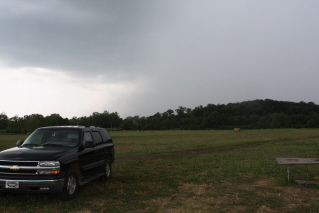
With the dawning of the new week, a welcome cold front has begun to drop the temperatures down to a much more pleasant level. A brief rain over the weekend filled some of the plastic over our units with water -- so the first task of the day was to bail out the water. Below, Michael dips water while Andrew, Skylar, Ellen-Craig, and Zach form the bucket brigade. With only two weeks left in our project, our time will have to be carefully spent trying to get as much information as possible -- while still trying to finish up on time. Today, we cleaned up a number of the units for a photograph. While some of the features in the center of the structure are visible, their outlines are still indistinct and difficult to interpret. Below, the large rectangular pit in the center is highlighted in blue; an overlapping trench in white; and an adjacent large post or pit in yellow. We remain uncertain whether this structure had a roof or not. It clearly had a significant circular wall around the outside, but may have been an enclosure with smaller buildings inside it -- rather than a roofed structure. In order to try to answer this question in our few remaining days, we opened several new units in the southwest quadrant of the structure -- hoping to find evidence of large roof support posts (or not!). Below, Matthew, Austin, Alex, and Andrew finish stripping the sod from two new units in the interior. Tomorrow promises to be even cooler, so we hope to be able to move along at a better pace.


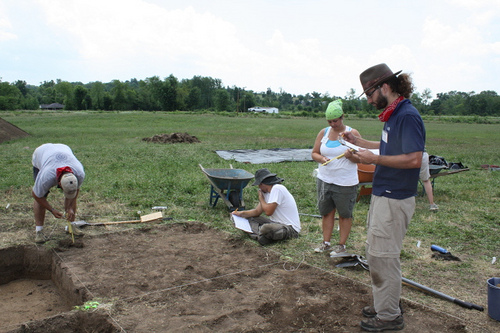
Tuesday morning opened with a welcome 60 degrees -- but not much of a dawn with the heavy fog shrouding Mound 2 and the site. The fog stayed with us through the early morning hours as we uncovered the excavation area. After uncovering the units, we spent a rousing several minutes chasing a field mouse at high speed through the excavations -- eventually it was captured and released across the field. Much of our work today focused on taking a number of units to a greater depth -- and cleaning things up for photographs tomorrow. Below is a photograph of the profile of the northern wall trench. The edited photo below shows the east outline of the trench in blue and the plan of the unexcavated part of the trench in yellow. In the early afternoon, we were visited by several distinguished archaeologists from around the country. Below, Dr. David Dye (University of Memphis), Dr. F. Kent Reilly (Texas State University), and Dr. James A. Brown (Northwestern University) examine the wall trench. Dr. Brown is visiting with us for a couple of days while presenting a lecture to the Middle Cumberland Archaeological Society in Nashville. Below, he chats with several of the field school students after the MCAS meeting. After a long day, we finally got back home close to midnight -- with an early day ahead tomorrow!






Although 5:00 am came quite a bit too early this morning after our late night in Nashville, it was cool and overcast -- continuing our welcome relief from the high 90s of last week. Dr. Brown joined us again this morning to provide insights and thoughts on the large structure. Below, he discusses details with Field Director Brandy Dacus. On the west side of the structure, we continued our search for a possible entrance -- the architecture of the entrance could provide some needed clues about whether our structure was an enclosure or a roofed building. In a newly excavated 1x2 meter unit, some interesting, but perplexing new features emerged. This cluster of posts, burned clay, and plaster is outside the circular structure. Our four interior units inside the southwestern quadrant of the structure failed to yield any evidence of large roof support posts, although a row of smaller posts suggests an interior partition of some kind. These posts are highlighted below -- the row ends in two double posts. Having discovered that we need to take all of our units down another 10-15 centimeters to see the features clearly -- we renewed our efforts during the cooler weather.



Without complaint, my thermometer read a chilly 58 degrees at 6:00 this morning -- continuing our welcome respite from the more typical heat of early July. Having excavated several of the interior units another 10-15 cm over the past few days, we took the opportunity to clean things up and take some photographs. Below, the center of the structure has started to yield some insights into the outlines of key features -- but they still do not form a familiar pattern (view to the north). A large rectangular pit is located at the very center of the structure -- highlighted in blue. Several trenches, pits and posts are also now becoming visible (outlined in yellow). A closer view of the edge of this large rectangular pit shows the distinctive outline -- the slightly raised pedestal in the center is a dense cluster of burned thatch and cane, along with daub. Another view to the southwest is shown below. Here, a large post or pit is highlighted in yellow; the rectangular pit highlighted in blue; and several other features outlined in white. This central rectangular pit is an unusual feature for Mississippian period sites. It resembles an old excavation trench -- perhaps from the late 1800s. But, the contents and texture of the fill do not suggest that it is a modern excavation. Below, a closer shot shows the large post or pit in the center (and a smaller post at the left center). An unusual piece of burned clay showing the impression of a small post is shown below. Thanks to the interest of the crew, we stayed an extra hour or so in the afternoon to continue work in the cool weather. We have a lot to finish in the next few days.





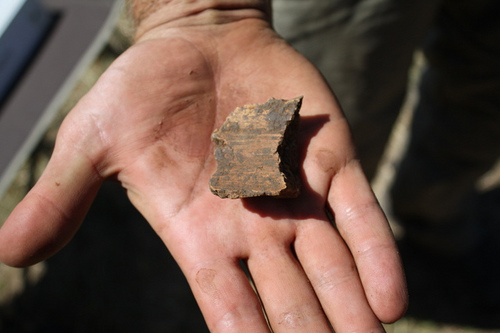

Although a little bit warmer than yesterday, still much more pleasant than usual for an early July Tennessee morning. In order to fully document the walls of the circular enclosure, several crews have been working on additional cross-sections on the north, east, and south sides. Below Amber S. and Mark excavate a section across the trench on the south while Ginny screens in the background. In the foreground, Ellen-Craig and Zach draw the east profile of their unit. A number of features continue to appear outside the circular structure. Below, a cluster of burned thatch and cane was uncovered just outside the south wall of the structure. As we start to close on the last few days of the project, making sure all of our paperwork is up to date is critical. Below, project director Emily Beahm checks forms for accuracy and completeness. Later in the day, the cross-section of the south wall trench was complete. Unfortunately, the prehistoric excavators struck a large section of bedrock while building this part of the trench -- but the three-step design is still evident.
With three cross-sections of the wall complete on the south, west, and north, we started a careful excavation of the entire exposed part of the trench in our eastern unit. Below is the trench with 10 cm of fill removed. A cluster of limestone can be seen in the lower left and a burned post in the right center of the trench. Tomorrow is the last of our volunteer days, and we are expecting several friends and family to help out.





Today was the last of our four Saturday "Volunteer Days" -- a beautiful overcast July day with a refreshing breeze. We enjoyed the company of several volunteers as we worked on a number of units and features. Below, Amy G. shovel skims one of the central units while her friends Heather and Amanda screen the dirt with Kevin. On the east end, Ellen-Craig and Rusty work with volunteers Gage, Joey, and Cindy (Ellen-craig's mom). Today is Ellen-Craig's last day -- as she leaves for a field school in Belize tomorrow. Over on the west side units, Libby and Alex worked with several volunteers, including Rick (Lee's dad), Riley (Libby's dad), Angelia, Andrea and Frank (Alex's mom and grandparents). In the central units, we began a cross-section of the mysterious rectangular pit. Below, Skylar cleans up the northern edge of the pit. On the east side, work continued on excavation of the wall trench. Below Brandy cleans up the bottom of Level 2 with assistance from volunteer Ron. Below, level 2 shows a much clearer picture of the architecture within the trench. The dark stain at left is the deepest step, the yellowish-brown in the middle is the second-deepest, and the darker stain on the right is the shallowest --and still contains the remnants of several carbonized posts. A closeup of one of these carbonized posts is shown below. The posts are about 7-8 inches in diameter -- this one will provide some excellent material for future radiocarbon dating. Elsewhere, other students began investigations of other interior features close to the center of the structure. Below, Brandon and Amy H. complete a cross-section of the large post or pit in the center. At the screen, Brandon's aunts Julia and Candace screen along with his uncle Patrick. Upon completion, this feature appeared to be a basin shaped pit -- burned at the bottom. A number of other visitors and volunteers stopped by today, including Stan and Tracie (Brandy's dad and his wife) and Mike and Carrie (two of Rusty's friends). Our thanks to all of the volunteers -- we made a lot of progress today. Tomorrow, we will celebrate our nation's independence -- and rest up for the crunch of our last week!



